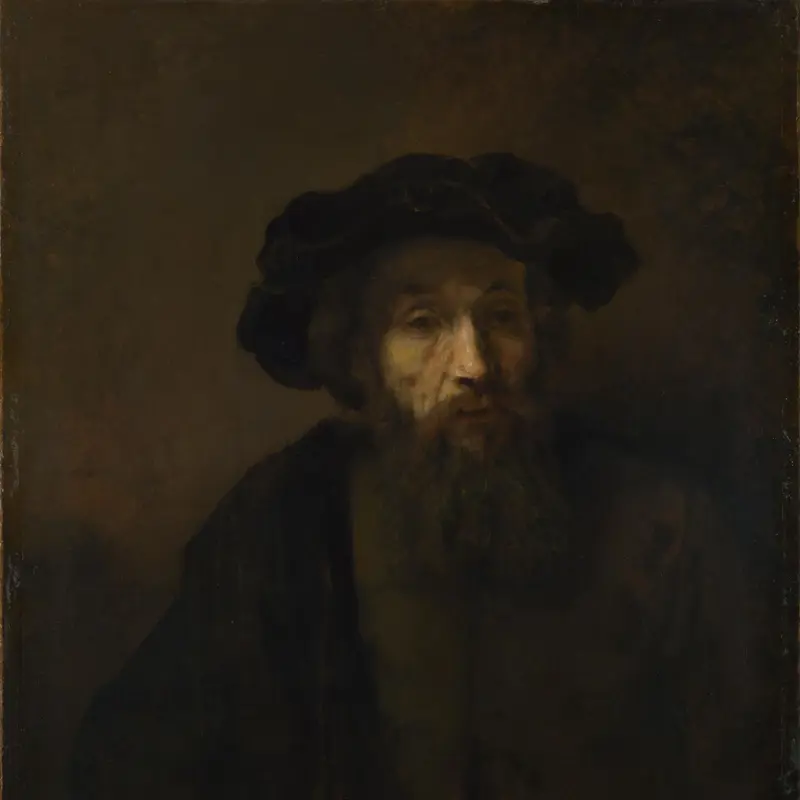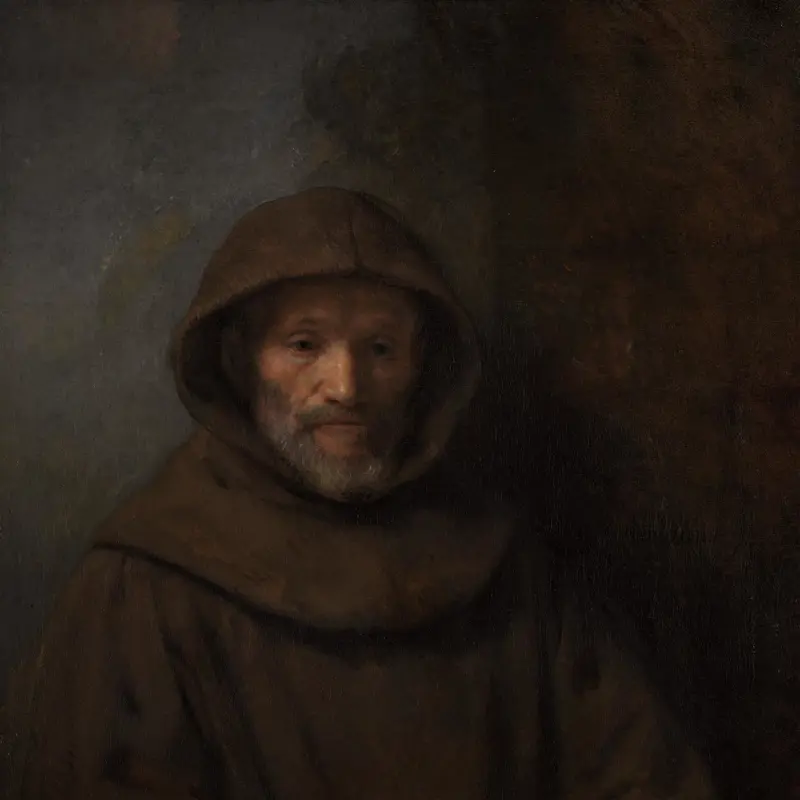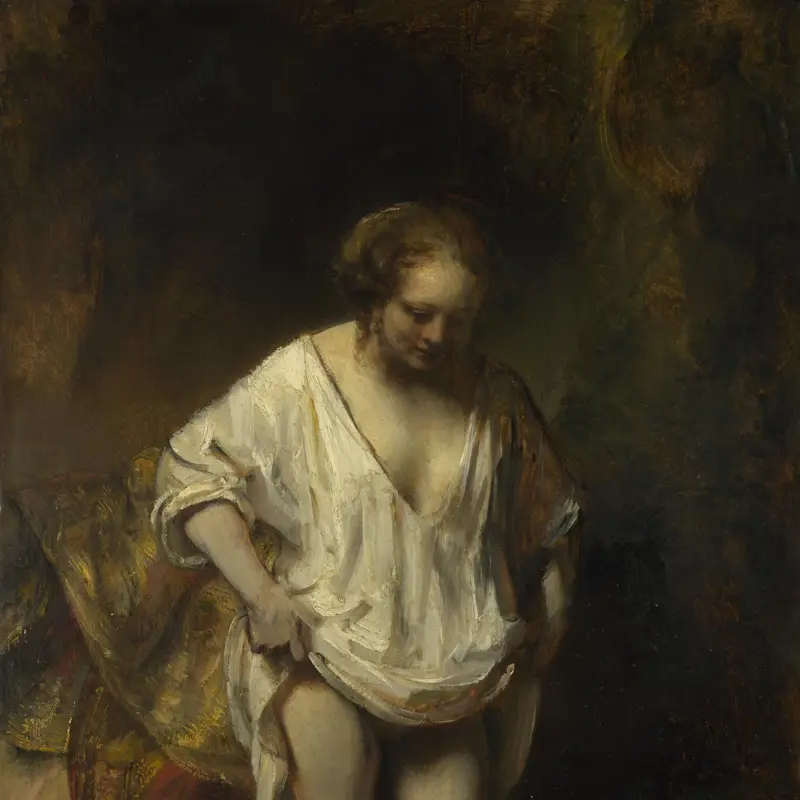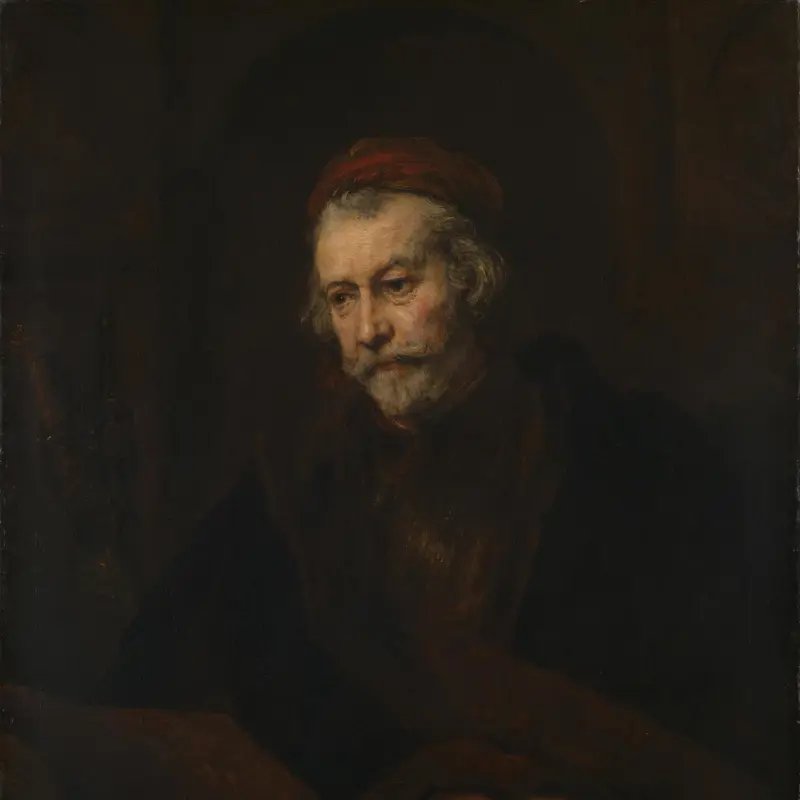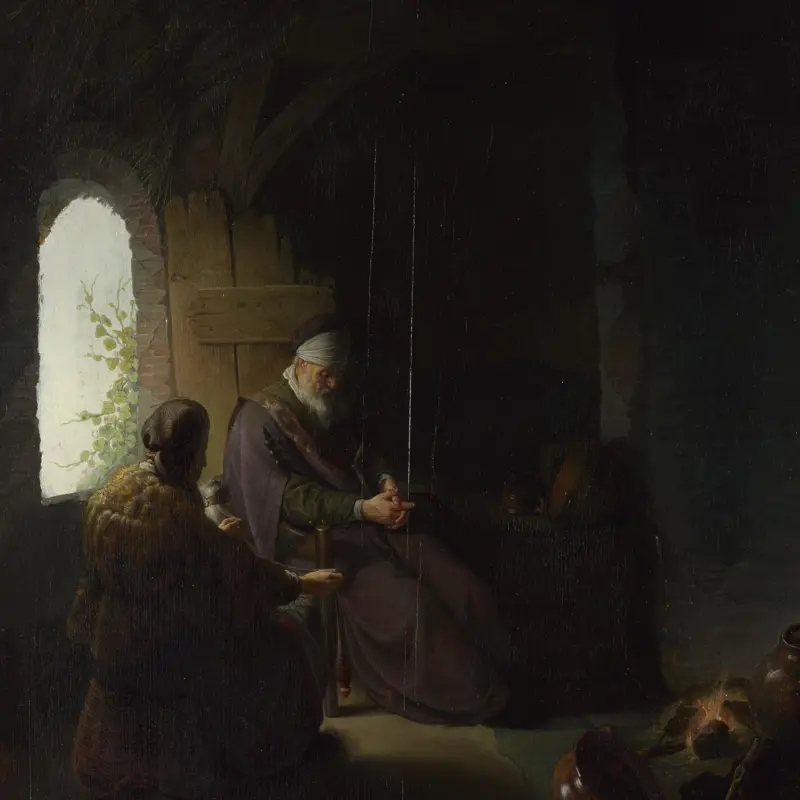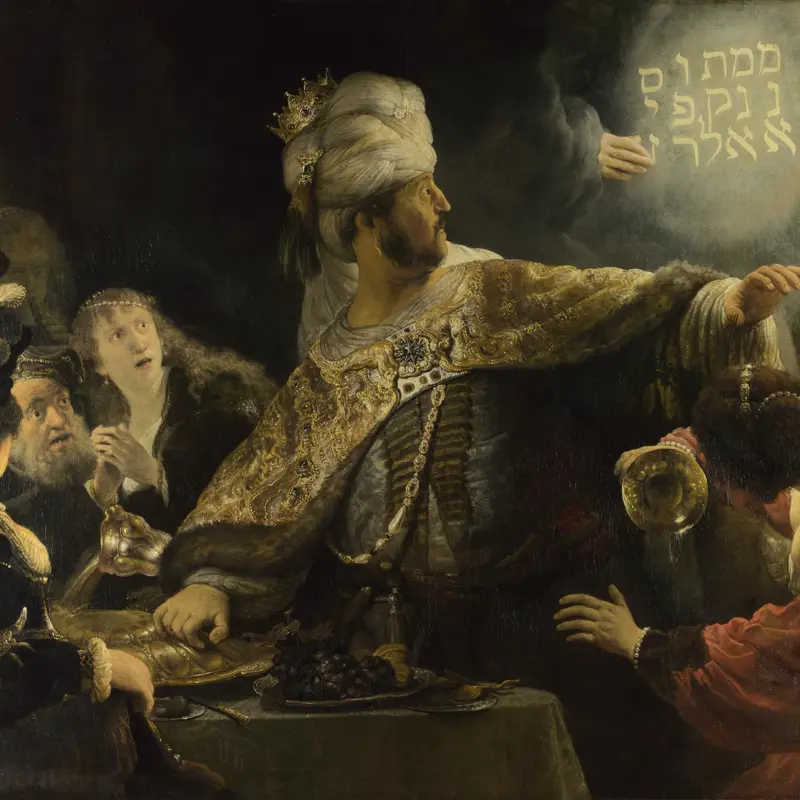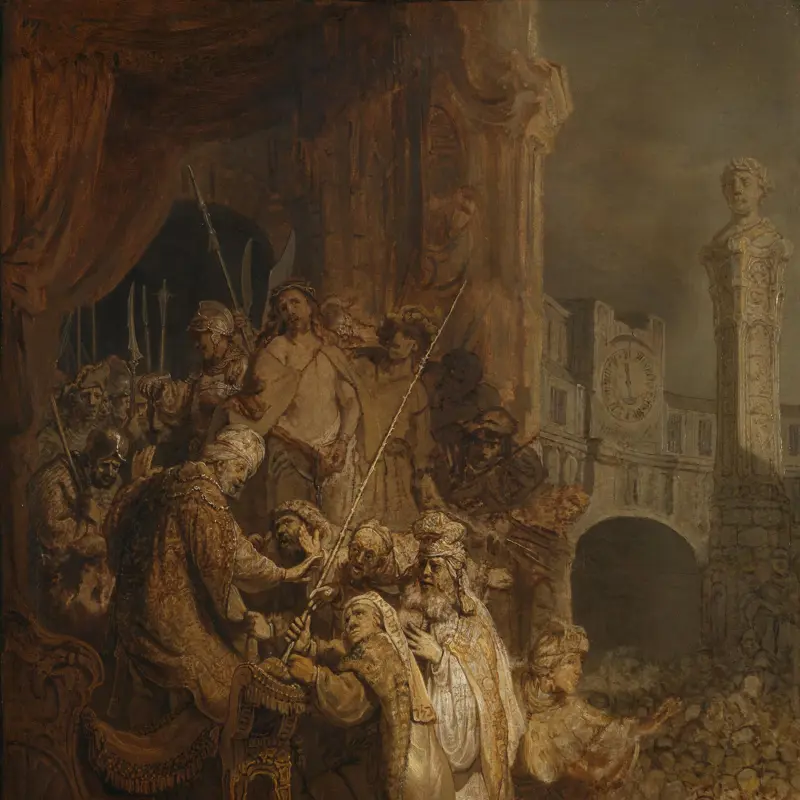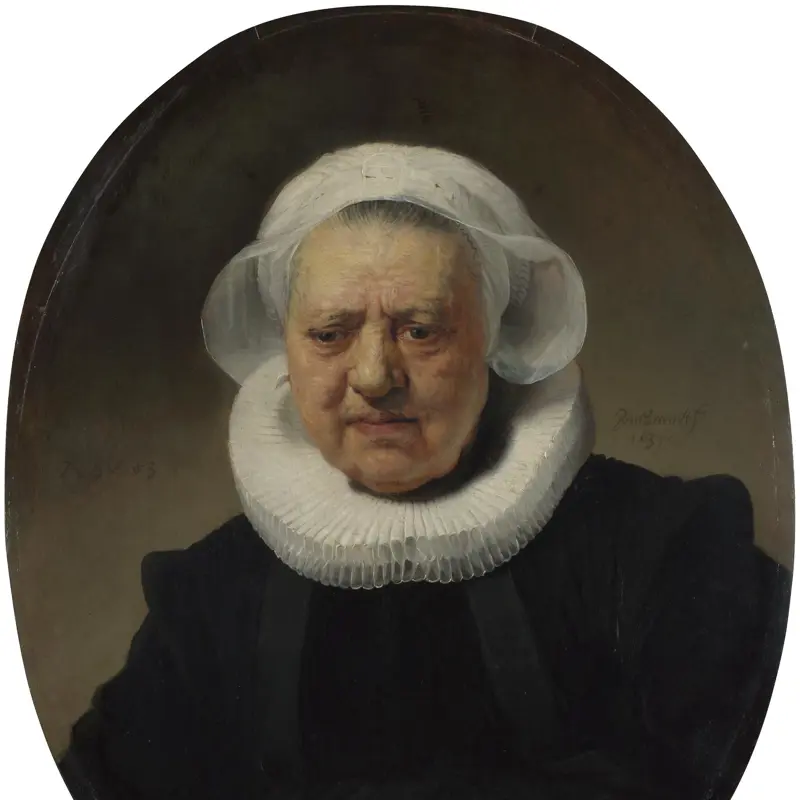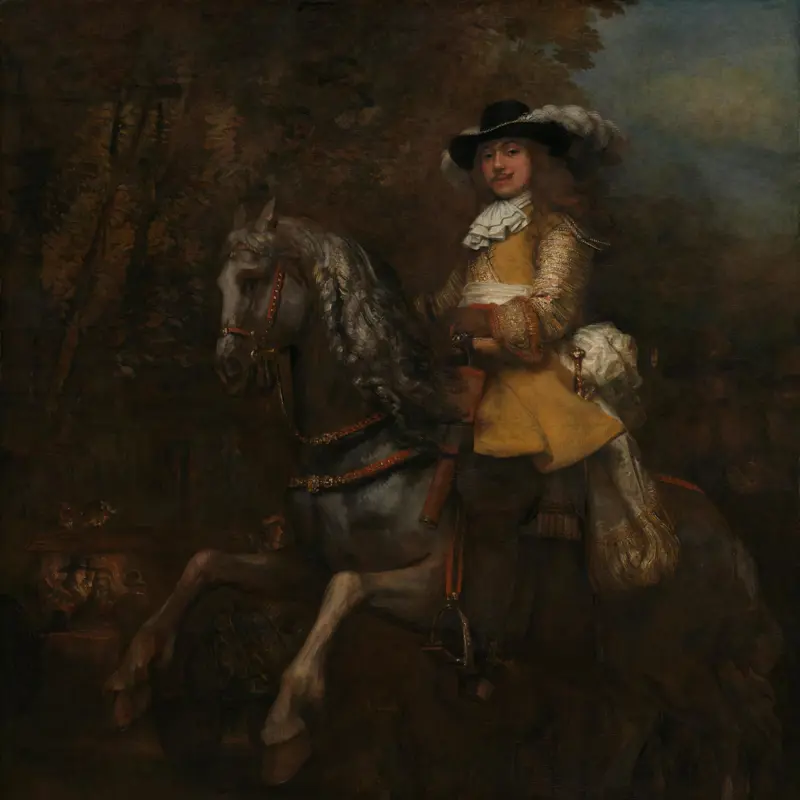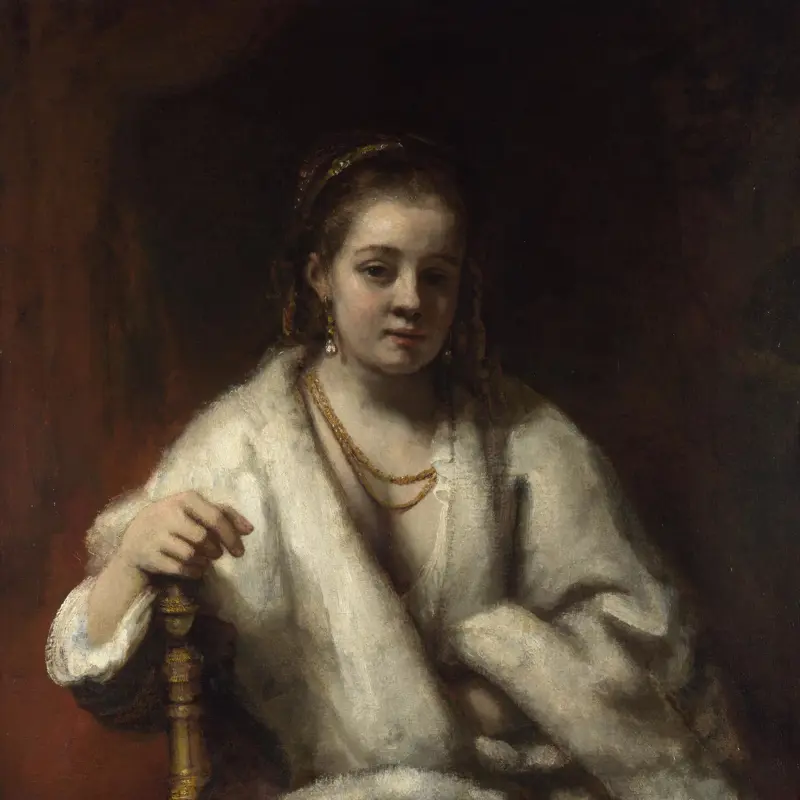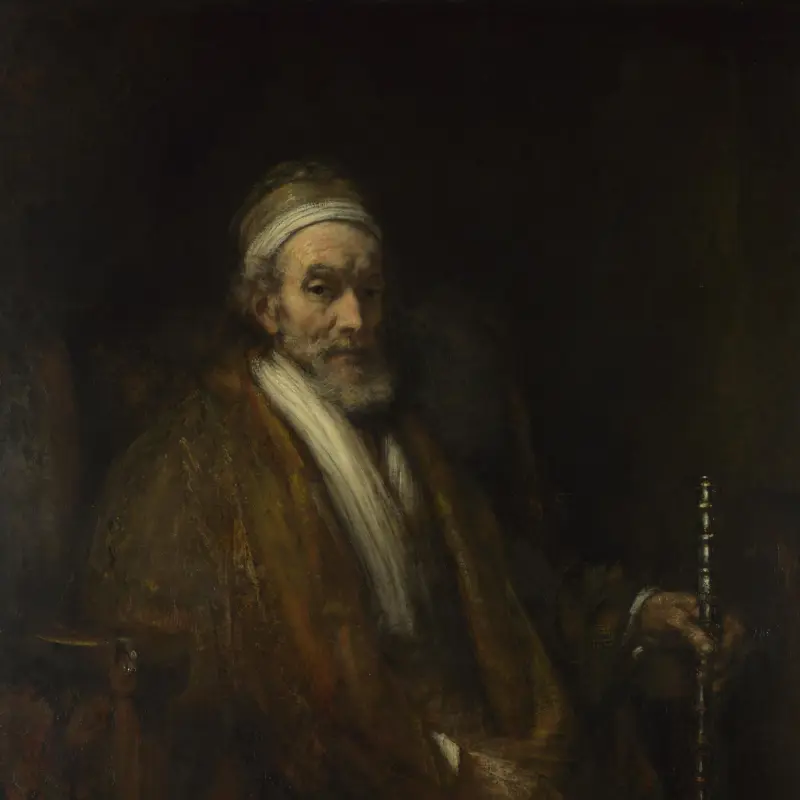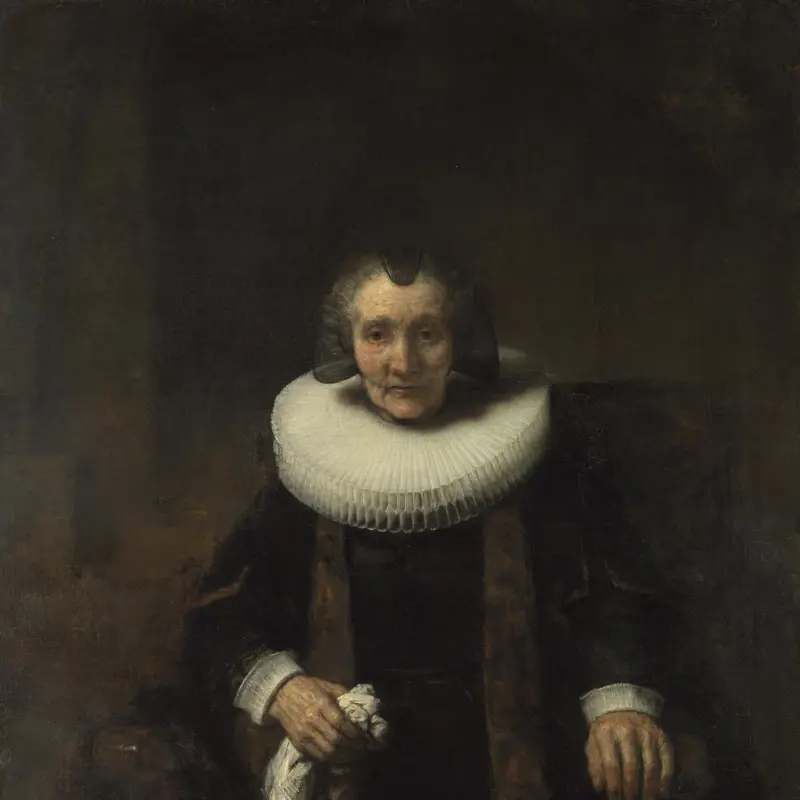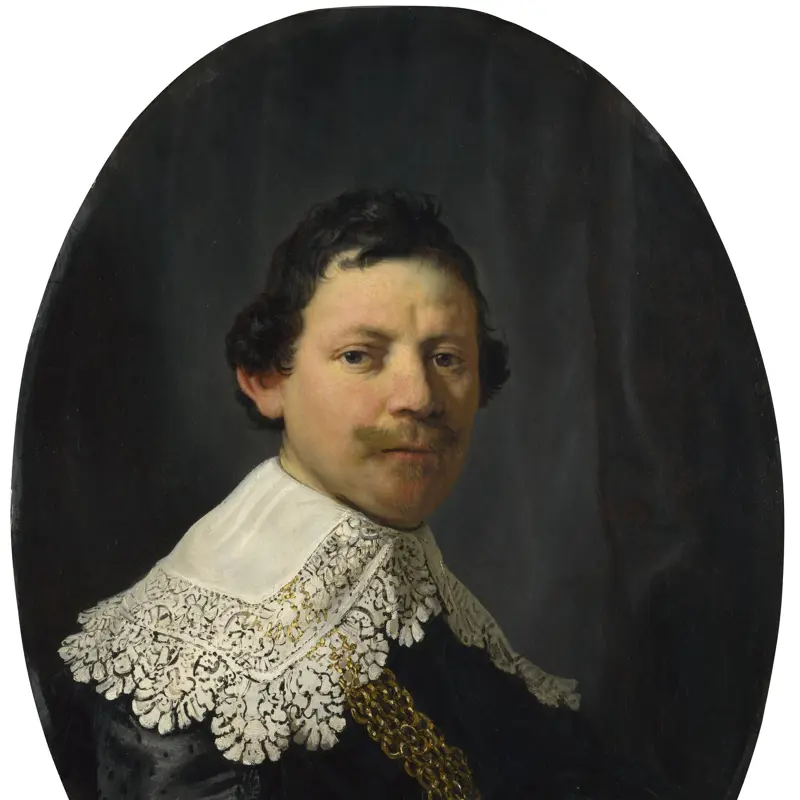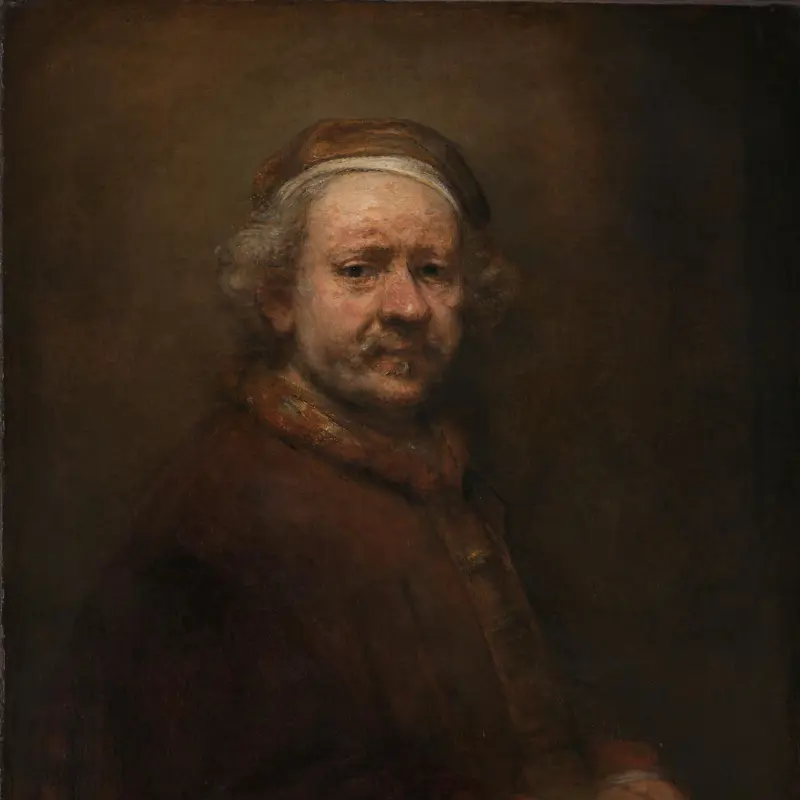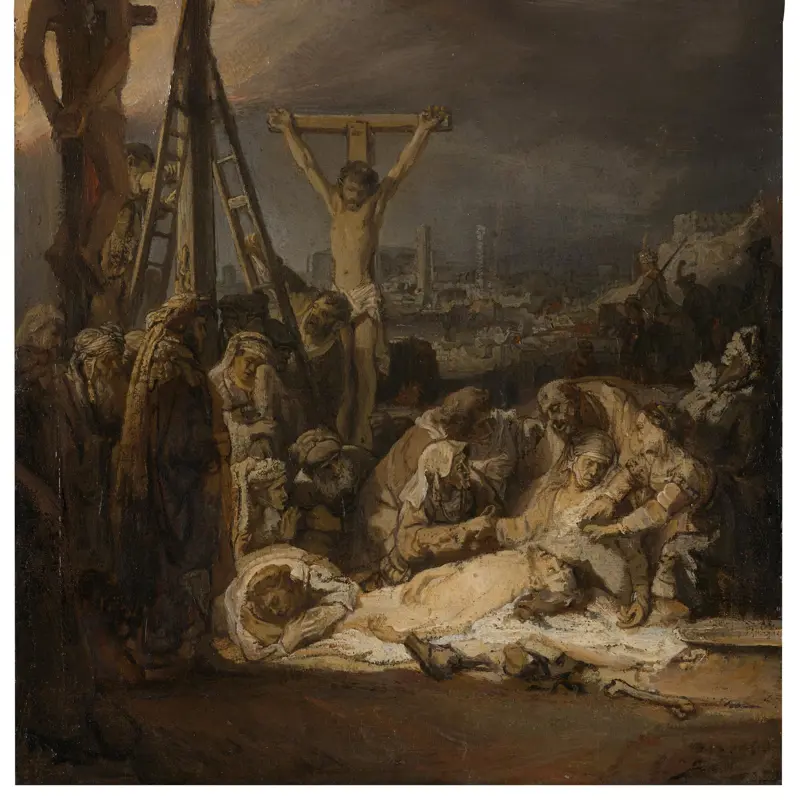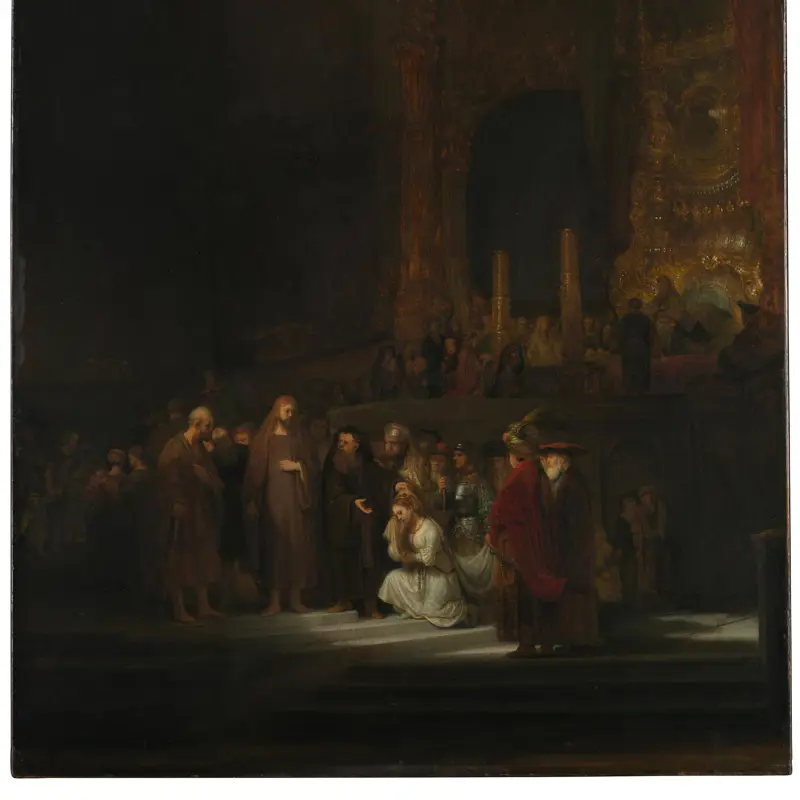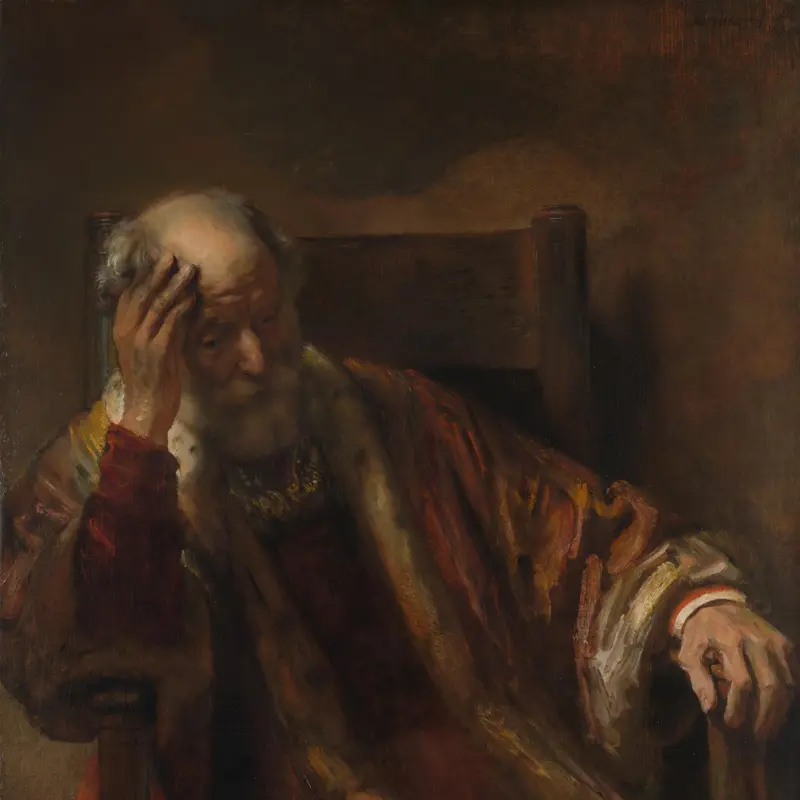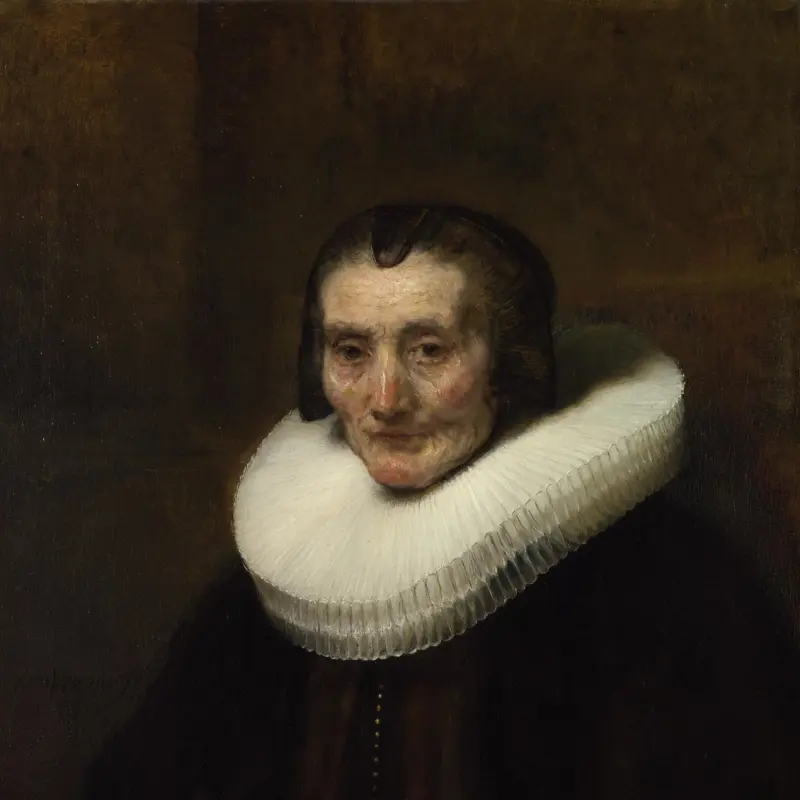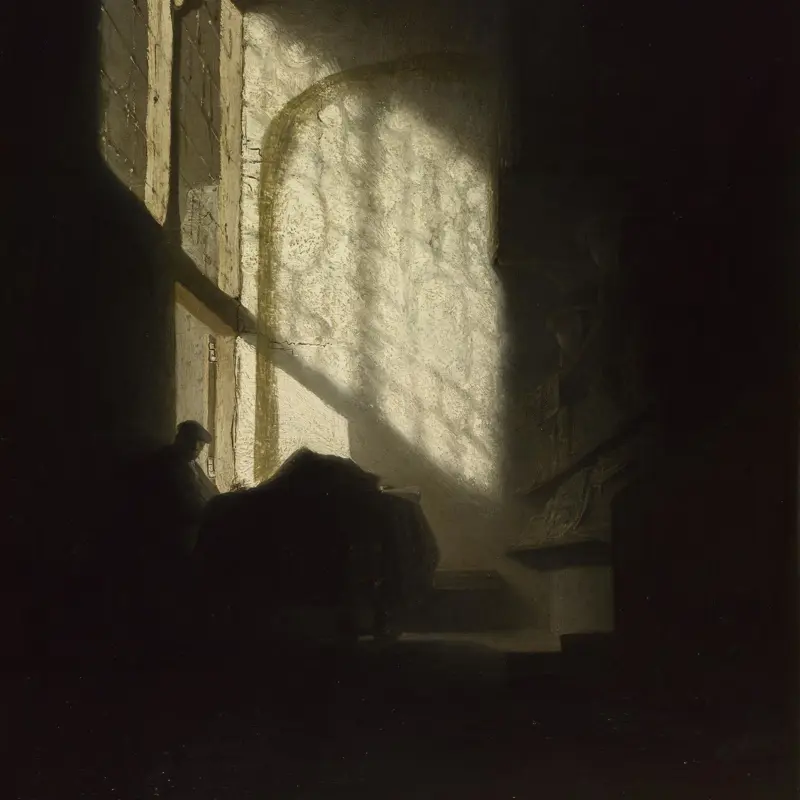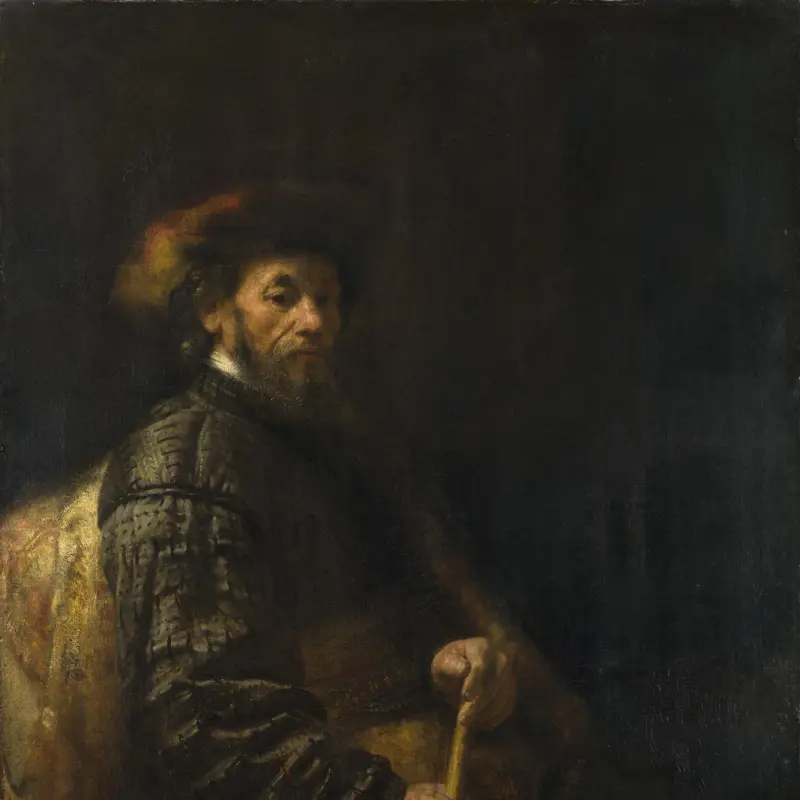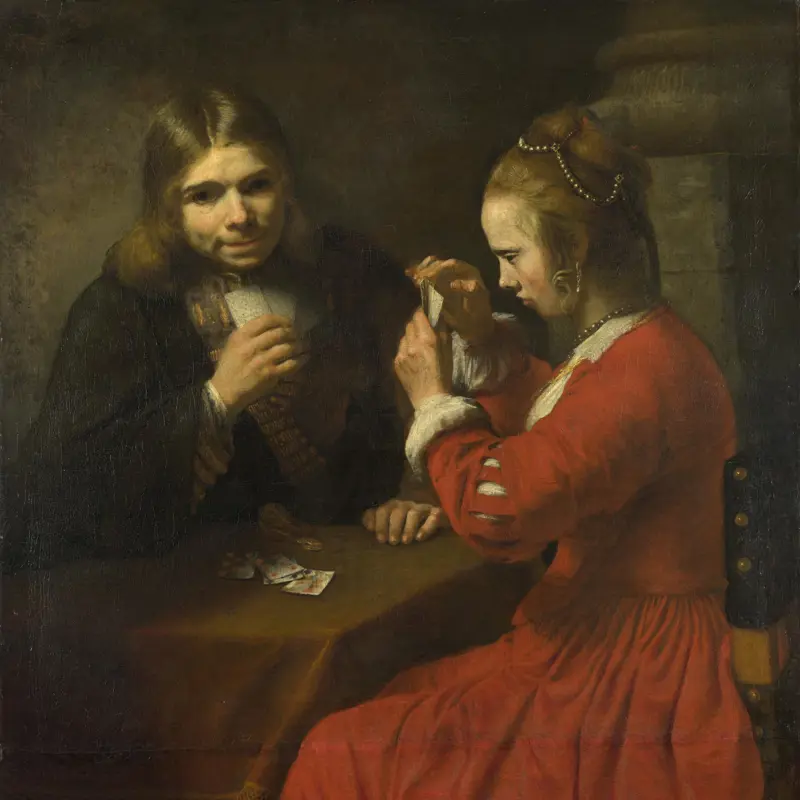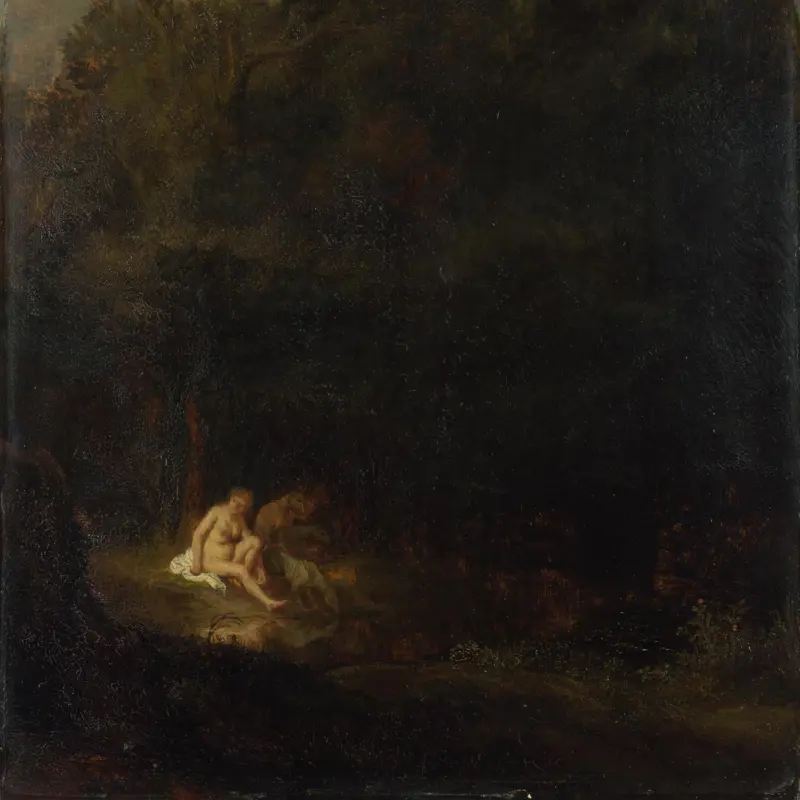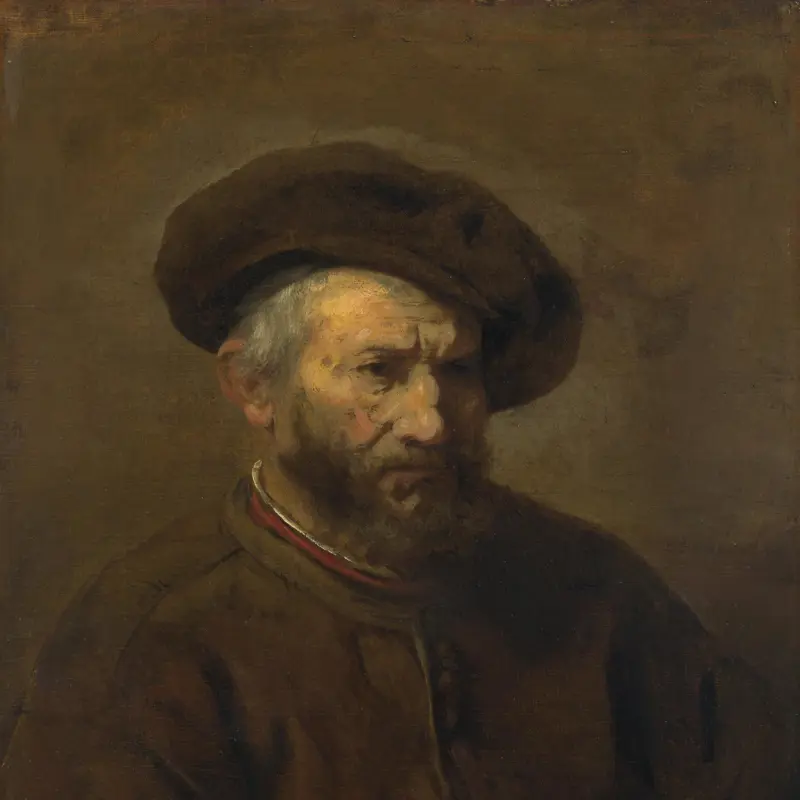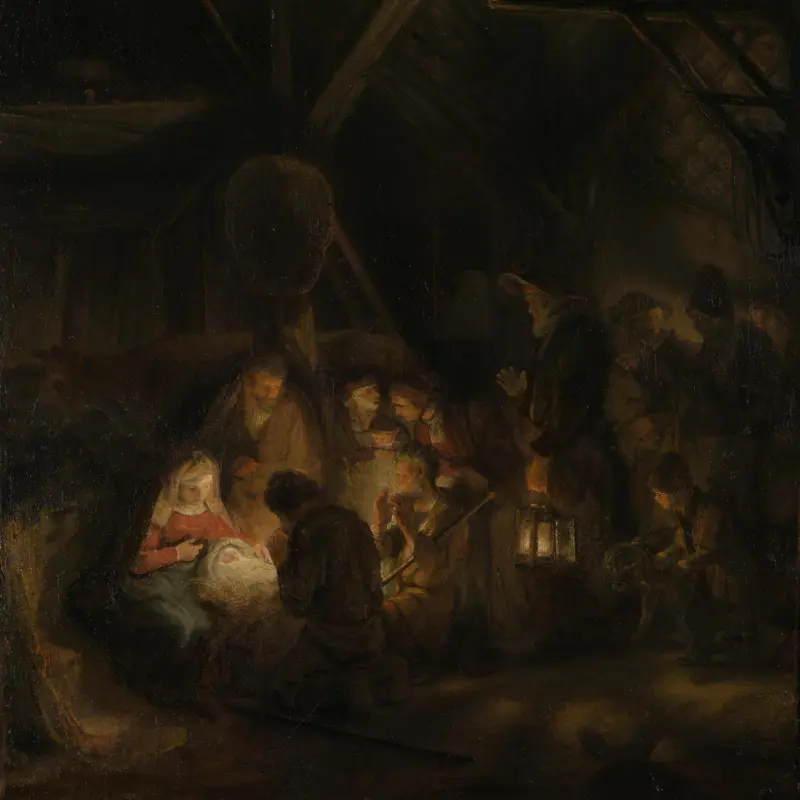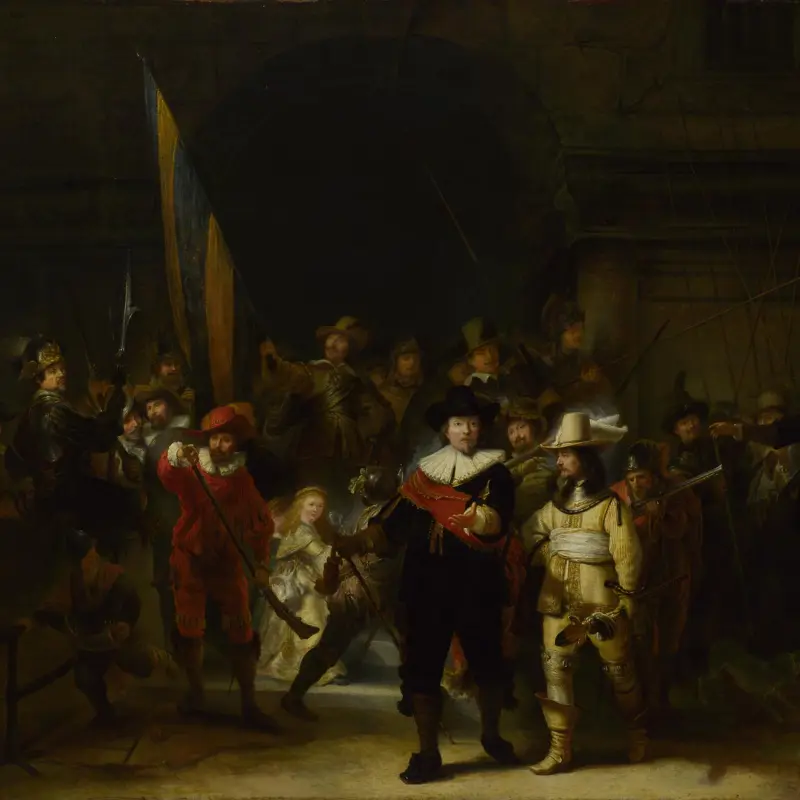Rembrandt’s 'Saskia van Uylenburgh in Arcadian Costume' travelled the UK in 2022 and 2023 as part of our Masterpiece tour. Ed, one of our Educators, and Laura, our Associate Curator of Renaissance Painting, explore the stories surrounding this portrait of Rembrandt's wife, Saskia van Uylenburgh.
Rembrandt, 'Saskia van Uylenburgh in Arcadian Costume', 1635
About the work
Overview
Saskia van Uylenburgh, the daughter of a burgomaster of Leeuwarden in Friesland, was Rembrandt’s first wife. Here, she is 23 years old; they have been married for a year. She is dressed as Flora, the Roman goddess of spring and fertility.
Her gorgeous gown is a seventeenth-century version of Renaissance dress and she carries an enormous bunch of spring flowers that includes tulips, roses, primulas and tiny pinks. More flowers decorate her neck and forehead. Pearls hang from her ears and peep from the crown of her head. Delicate green leaves wind round the stick in her other hand.
In their seven years of marriage, Saskia had four children. Only their son Titus survived. A year after he was born, Saskia died, so the ‘goddess of spring’ never reached the summer of her life.
Key facts
Details
- Full title
- Saskia van Uylenburgh in Arcadian Costume
- Artist
- Rembrandt
- Artist dates
- 1606 - 1669
- Date made
- 1635
- Medium and support
- Oil on canvas
- Dimensions
- 123.5 × 97.5 cm
- Acquisition credit
- Bought with contributions from the Art Fund, 1938
- Inventory number
- NG4930
- Location
- Room 22
- Collection
- Main Collection
- Frame
- 19th-century English Frame
Provenance
Additional information
Text extracted from the ‘Provenance’ section of the catalogue entry in Neil MacLaren, revised and expanded by Christopher Brown, ‘National Gallery Catalogues: The Dutch School: 1600–1900’, London 1991; for further information, see the full catalogue entry.
Exhibition history
-
2014Loan to Kelvingrove Art Gallery and MuseumKelvingrove Art Gallery and Museum (Glasgow City Council)15 October 2014 - 17 May 2015
-
2017Rubens and RembrandtThe National Gallery (London)22 March 2017 - 6 August 2017
-
2022The National Gallery Masterpiece Tour 2022Oriel Davies Gallery12 March 2022 - 26 June 2022The Beacon Museum24 September 2022 - 8 January 2023Carmarthenshire County Museum14 January 2023 - 23 April 2023
-
2024Rembrandt – Hoogstraten: Color and IllusionKunsthistorisches Museum Wien8 October 2024 - 12 January 2025
Bibliography
-
1756P. Remy, Catalogue raisonné des tableaux, sculptures, tant de marbre que de bronze, desseins et estampes des plus grands maîtres… qui composent le cabinet de feu monsieur le Duc de Tallard, Paris, 22 March 1756 - 13 May 1756
-
1829
J. Smith, A Catalogue Raisonné of the Works of the Most Eminent Dutch, Flemish, and French Painters: In Which is Included a Short Biographical Notice of the Artists, with a Copious Description of Their Principal Pictures […], 9 vols, London 1829-1842
-
1854G.F. Waagen, Treasures of Art in Great Britain: Being and Account of the Chief Collections of Paintings, Drawings, Sculptures, Illuminated Mss. […], vol. 2, trans. E. Eastlake, London 1854
-
1857G.F. Waagen, Treasures of Art in Great Britain: Being and Account of the Chief Collections of Paintings, Drawings, Sculptures, Illuminated Mss. […], translated from German by Elizabeth Eastlake, 3 vols, London 1857, vol. 3
-
1883J.M. Gray, Notes of the Edinburgh Loan Exhibition of 1883, Edinburgh 1883
-
1890A.F. Steuart, Catalogue of the Pictures at Dalkeith House, Dalkeith 1890
-
1893É. Michel, Rembrandt, sa vie, son oeuvre et son temps, Paris 1893
-
1897W. von Bode and C. Hofstede de Groot, The Complete Work of Rembrandt, 8 vols, Paris 1897
-
1898A. MacKay, Catalogue of the Pictures in Montagu House Belonging to the Duke of Buccleuch, London 1898
-
1907C. Hofstede de Groot, Catalogue Raisonné of the Works of the Most Eminent Dutch Painters of the Seventeenth Century, 10 vols, London 1907
-
1907C. Hofstede de Groot, Catalogue Raisonné of the Works of the Most Eminent Dutch Painters of the Seventeenth Century, 10 vols, London 1907
-
1929R.C. Witt, Exhibition of Dutch Art 1450-1900 (exh. cat. Royal Academy of Arts, 1929), London 1929
-
1939Anon., 'Rembrandt's Saskia as Flora', Apollo, XXIX, 1939, pp. 17-21
-
1941E. Kieser, 'Uber Rembrandts Verhältnis zur Antike', Zeitschrift für Kunstgeschichte, X, 1941
-
1960Maclaren, Neil, National Gallery Catalogues: The Dutch School, 2 vols, London 1960
-
1961J. Held, 'Flora, Goddess and Courtesan', in M. Meiss (ed.), De Artibus Opuscula, XL: Essays in Honour of Erwin Panofsky, New York 1961, pp. 201-18
-
1973M. Louttit, 'The Romantic Dress of Saskia van Ulenborch: Its Pastoral and Theatrical Associations', The Burlington Magazine, CXV/842, 1973, pp. 317-26
-
1983A.M. Kettering, The Dutch Arcadia: Pastoral Art and Its Audience in the Golden Age, Ottawa 1983
-
1983
C. Brown, 'Rembrandt's "Saskia as Flora" X-Rayed', in A.-M. Logan (ed.), Essays in Northern Art presented to Egbert Haverkamp-Begemann on his Sixtieth Birthday, Doornspijk 1983, pp. 48-51
-
1988S. Alpers, Rembrandt's Enterprise: The Studio and the Market, London 1988
-
1988D. Bomford et al., Rembrandt (exh. cat. The National Gallery, 12 October 1988 - 17 January 1989), London 1988
-
1989J. Mills and R. White, 'Paint Media Analyses', National Gallery Technical Bulletin, XIII, 1989, pp. 69-71
-
1989A. Werbke, 'Rembrandts "Landschaftsradierung mit drei Bäumen" als visuell-gedankliche Herausforderung', Jahrbuch der Berliner Museen, XXXI, 1989, pp. 225-50
-
1991Maclaren, Neil, revised by Christopher Brown, National Gallery Catalogues: The Dutch School, 1600-1900, 2nd edn (revised and expanded), 2 vols, London 1991
-
1991C. Grimm, Rembrandt selbst: Eine Neubewertung seiner Porträtkunst, Stuttgart 1991
-
1991C. Brown, J. Kelch and P.J.J. van Thiel, Rembrandt: The Master and his Workshop (exh. cat. Gemäldegalerie SMPK at the Altes Museum, 12 September - 10 November 1991; Rijksmuseum, 4 December - 1 March 1992; The National Gallery, London, 25 March - 24 May 1992), New Haven 1991
-
1992J.L. Williams, Dutch Art and Scotland: A Reflection of Taste (exh. cat. Scottish National Gallery, 13 August - 18 October 1992), Edinburgh 1992
-
1992J.M. Gray, 'Notes of the Edinburgh Loan Exhibition of 1883', in J.L. Williams, Dutch Art and Scotland: A Reflection of Taste, Edinburgh 1992, pp. 16-17
-
1993C. Tümpel, Rembrandt: All Paintings in Colour, Antwerp 1993
-
1993A. Wilson, National Art Collecting: A Celebration of the National Art Collections Fund, London 1993
-
1999S. Schama, Rembrandt's Eyes, New York 1999
-
1999J.L. Arias Bonel, 'Rembrandt y Ganimedes', Goya, 270, 1999, pp. 146-52
-
2000H. Berger, Fictions of the Pose: Rembrandt Against the Italian Renaissance, Stanford 2000
-
2001
C. Baker and T. Henry, The National Gallery: Complete Illustrated Catalogue, London 2001
-
2001J.L. Williams, Rembrandt's Women (exh. cat. Scottish National Gallery, 8 June - 2 September 2001; Royal Academy of Arts, 22 September -16 December 2001), Edinburgh 2001
-
2002A. Chong, Rethinking Rembrandt, Boston 2002
-
2002S.S. Dickey, 'Rembrandt and Saskia: Art, Commerce, and the Poetics of Portraiture', Fenway Court, XXX, 2002, pp. 17-47
-
2004K.A. Schröder, Rembrandt (exh. cat. Albertina, 26 March - 27 June 2004), Vienna 2004
-
2006M. De Winkel, Fashion and Fancy: Dress and Meaning in Rembrandt's Paintings, Amsterdam 2006
-
2006D. Bomford et al., Rembrandt, London 2006
-
2006D. Bull et al., Rembrandt-Caravaggio (exh. cat. Rijksmuseum, 24 February - 18 June 2006), Zwolle 2006
-
2008D. Hirschfelder, Tronie und Porträt in der niederländischen Malerei des 17. Jahrhunderts, Berlin 2008
About this record
If you know more about this work or have spotted an error, please contact us. Please note that exhibition histories are listed from 2009 onwards. Bibliographies may not be complete; more comprehensive information is available in the National Gallery Library.

